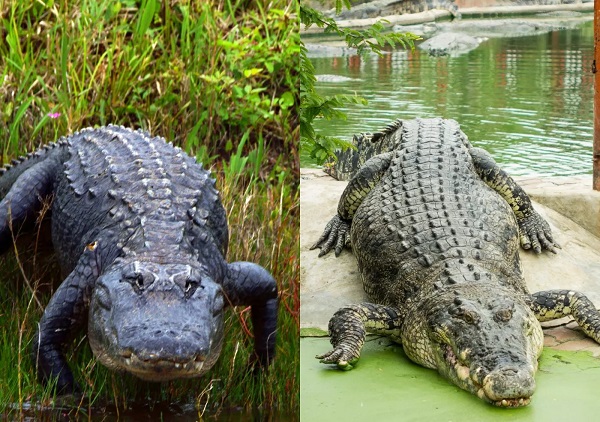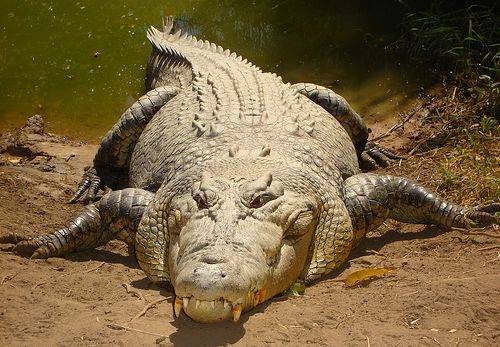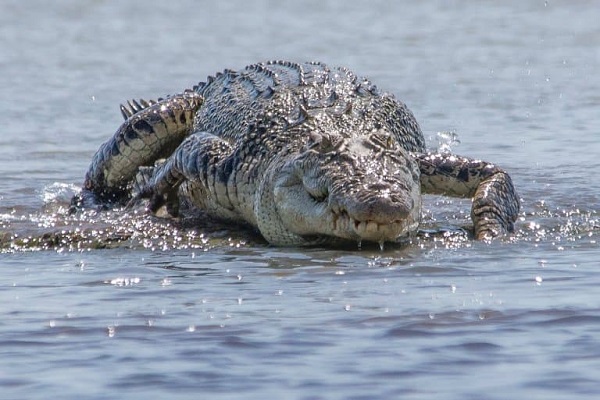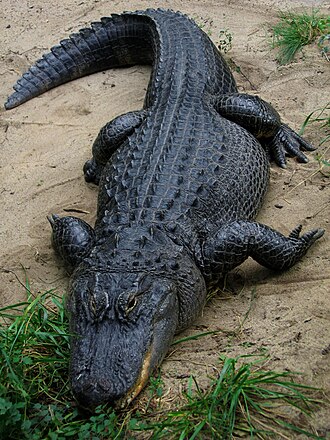
Crocodilians are perhaps the most prehistoric-looking animals on the planet. As an order, they’re survivors of the K-T Extinction event that killed off the dinosaurs and 80% of all animal species.
Today, while they look a lot like giant lizards, they’re more closely related to birds than other reptiles, having separated from the ancestor of modern birds around 250 million years ago.
Also, alligators and crocodiles are descended from ancient ancestors that lived alongside the dinosaurs. Their last common ancestor lived between 90 and 100 million years ago, and since then, both creatures have developed extreme physical attributes that make them apex predators in their habitats.
Some of the largest crocodile-like animals to have ever lived, like Sarcosuchus imperator and the marine giant Machimosaurus rex, would have reached more than 10m long and weighed up to eight tonnes. But these huge crocodiles were only distant ancestors of modern crocodilians, predating the order at around 120 million years ago.
Today, crocodilians can be grouped into three main families: The gharials, in the Gavialidae family, Indian crocodilians distinctive for their slender, long snouts; and Crocodylidae and Alligatoridae, the crocodiles and alligators, respectively.
These two are harder to differentiate, and with such a widespread distribution, there’s some overlap in their habitats.
Have a glance at the common differences between these creatures below.
1. Crocodiles Are Global
Alligators were once prevalent all over the globe, but now comprise only two species, both in the genus Alligator. In the Southern US, there is the American alligator, a large and powerful crocodilian that grows up to nearly 500 kg and primarily feeds on the annoying little dogs of retired Floridians.
Then, there is the relatively diminutive Asian variety, the Chinese alligator. This one rarely tops 50kg and is restricted to just three Northeastern Chinese provinces. The very limited distribution of alligators represents a collapse of their populations all over the globe, having once been widespread across tropical and subtropical regions.

Crocodiles, on the other hand, are far more numerous and diverse. There are 18 species known and one in the pipeline, and there is generally very little overlap in their distribution. But at risk of confusing things a little, the Caiman, a South American Alligartoid, is a third branch of crocodilian, more closely related to alligators than crocs, but neither one nor the other.
2. They Infrequently Share The Same Habitat
If you’re in Australia, having your leg torn off by a large crocodilian, it’s likely to be a crocodile. There are no native alligators in Australia, New Guinea, or even most of Asia, so if you’re in these places and you spot a crocodilian, it’s likely to be a crocodile.
Africa, too, has no alligator species left, and conversely, most of South America has no crocs. There is overlap in Northern South America, Central America and the Southernmost tip of Florida, where both crocs and alligators are native, but for the most part, their distributions are very different.
3. Crocodiles Dominate Salt Waters
Alligators are primarily freshwater animals, while crocs spread out into marine ecosystems too. So, while you do get freshwater crocs, if it’s in the ocean, it won’t be an alligator.
American crocs inhabit brackish waters, and even freshwater species tend to prefer estuarine environments where possible. Alligators love ponds, swamps and lakes. So, in general, if it’s in still, freshwater, it’s more likely to be an alligator.
4. They Are Slow To Mature
Crocodiles and alligators diverged around 90 million years ago. That’s plenty of time to grow into very different animals. For perspective, that’s around the same time that the first primates diverged from other placental mammals, while we were all just small, mouse-like creatures.
But while primates have created such stark differences as that which exists between mice and men, the genome for alligators and crocs has evolved much slower, and in terms of percentage DNA shared, the difference is much closer to that of humans and baboons: crocs and Alligators share roughly 93% of their DNA.
5. Crocodiles Grow Bigger
The record has it that an alligator from Florida is measured about six meters long and weighed 473 kilograms (1,043 lbs), although, it is an exceptional example, and for the most part, an average large male is around half this size.

Crocodiles also occasionally come in small packages, with the West African dwarf croc holding the title of smallest crocodile at 1.8 meters (5.9 feet) long. Adult crocs commonly hit four meters and weigh over 600kg, while the average chunky American alligator is around 3 meters long and rarely over 400kg.
But on the whole, croc species are larger than alligators and pack more of a punch. The largest croc on record was around 7 meters long and weighed over a tonne, more than twice that of the largest alligator. Crocodiles are said to be more aggressive in general, too.
6. They Have Different Head Sizes
Alligators are most recognisable by their wide, U-shaped snouts. Crocs generally have a narrower mouth, and even in huge species will look more triangular from the top down.
Narrower snouts tend to be more generalist in terms of what they’re capable of. A skinny nose is good for catching fish but can also grab a large mammal from the river bank if it comes along. Alligators, on the other hand, are built for crushing.

They usually go for larger prey animals, relative to their size, but also things like turtles, which need a powerful crushing bite to break into.
But if you’re not standing over it and you’re looking at these faces side-on, you can spot a difference in the way its jaws close. When the wide jaw of an alligator closes, its lower teeth disappear completely. A croc’s teeth protrude into the classic ominous grin of the world’s most infamous extant reptile.
7. Crocodiles Have Salt Glands
If you stood too long trying to pay attention to how it was running, chances are you’re now close enough to examine its tongue.
Crocodiles have lingual salt glands that help them keep their blood isotonic in the presence of salty foods. Just take a very close look at the side of the tongue and you might be able to spot them.
The coastal environment of crocodiles also determines their colour. Crocs are generally lighter, and more sandy in colour, while alligators are a darker, swampy green.
8. Crocs Can Gallop
This is probably at the lower end of the priority list if you’re ever near a sprinting crocodilian, but if you have the wherewithal, try to get a look at its gait.
Both crocs and alligators can run at around 17-18 km/h (11 mph), but alligators do so in a trot. Crocs, on the other hand, can switch into a fearsome gallop, so if you see all four legs off the ground at once, it’s a crocodile.
This has something to do with the length of the limbs. Alligators have much shorter humerus (upper arm) and femur (thigh) bones than crocs, which makes them stockier and waddling.
9. Alligators Are Less Dangerous
“Crocs are probably more dangerous, but a lot of what makes something perceived to be more dangerous is the density of humans occupying their habitats and thus frequency of negative encounters between humans and crocs or alligators,” Burbrink said.
Alligator attacks account for about one fatality a year in the U.S. and make up around 6 percent of attacks on humans by all crocodilian creatures globally. They tend to take place when a person is swimming or wading at the water’s edge. The University of Florida says that while unprovoked alligator attacks do happen, they are generally preventable, and the fatality rate is low. About 4 percent of attacks in the U.S. are fatal, with most encounters resulting in a bite and immediate release.
Saltwater and Nile crocodiles are responsible for far more human deaths than alligators. “All crocodilian species can be dangerous, but crocodiles hurt people most frequently,” Rosenblatt said.
Of these two species, Nile crocodiles are the deadlier. CrocBITE, the worldwide crocodilian attack database, says many fatal attacks by Nile crocodiles go unreported. Very rough estimates put fatalities in the hundreds. In comparison, the CrocBite website shows 20 fatal attacks by saltwater crocodiles so far in 2020.
“Nile and saltwater crocodiles have a long track record of eating people, so globally, those two stand out as by far the most dangerous crocodiles,” Wüster said. “In the Americas, neither American crocs nor Mississippi alligators habitually attack people, so there is not much to choose there.”
Marisa Tellez, co-founder of the Crocodile Research Coalition, said the area and population are important in assessing danger. She said the alligators in Louisiana and Florida are “definitely more bold” than those found in Belize.
10. Which Can Run Faster?
A saltwater crocodile, the fastest of all the crocodiles, swims at speeds of between 15 and 18 mph. American alligators are faster, clocking speeds of up to 20mph in the water.
Both are, however, far slower on land. Their bodies aren’t made for endurance running, so while they are extremely fast for short bursts, they can’t sustain that pace. One saltwater crocodile was recorded moving at 12 meters per second. That equates to almost 27 mph. But that was for just a quarter of a second.
On land, saltwater crocodiles can run for a longer amount of time at around eight to nine mph. American alligators can move at a similar speed, able to run at 7.5 to 9 mph for short distances.
The average human can sprint at speeds of between 12 and 18 mph for short bursts. The fastest human ever recorded, Usain Bolt, can run at 27 mph. So on land, the average human could probably outrun an alligator or crocodile, so long as they are not within the alligator or crocodile’s striking distance.
Running in zigzags is often given as advice if a crocodile or alligator is pursuing you. However, in an article about living with alligators, experts at the University of Florida said that is a myth: “This is a common misconception. First, it is rare for an alligator to pursue a human because humans are too large to be suitable prey. However, if an alligator does make an aggressive charge, run fast and straight (away from the alligator, of course). They usually do not run very far. But remember, they are most likely to charge at you if you are near their nest.“



